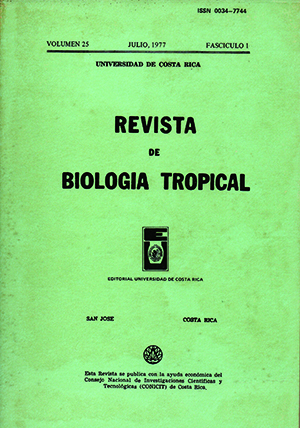Abstract
Commensal, phoretic relalionship and other types of associations of Diptera and land crabs are known from various parts of the world. A commensal relationship between an unidentified species of Sphaeroceridae (Diptera) and Cardisoma crassum Smith (Crustacea: Gecarcinidae) from Cocos Island, Costa Rica, is reported for the first time. The pattern of infection is closely similar to that of Drosophila and Lissocephala (Diptera: Drosophilidae) found associated with other gecarcinids elsewhere. The Sphaeroceridae are apparently obligatorily exploiting an exclusive niche in the restricted environment, suggesting a genetical mechanism of adaptation for this particular group of Diptera, possibly derived and favored by geographical isolation.References
Baylis, H. A. 1915. A parasitic oligochaete and other ¡nhabitants of the gill-chambers of land crabs. Ann. Mog. Not Hist., Ser. 8, 15: 378-381.
Bright, D. B. 1966. The land crabs of Costa Rica. Rev. Biol. Trop., 14: 183-203.
Bright, D. B., & C. L. Hogue 1972. A synopsis of the burrowing land crabs of the world and lillt of their arthropod symbionts and burrow associates. Los Angeles County Mus. Contr. Sd., 220: 1-58.
Canon, H. L 1967. The association between Drosophiln carcinophiln Wheeler and its host, the land crab Gecarcinus rericolo (L.). Amer. Midl. Nat., 78: 324-343.
Carson, H. L. 1971. The ewlogy 01 Drosophila breeding sites. Harold L. Lyon Arboretum, Lecture Number Two, University of Hawaii, 27 p.
Carson, H. L 1974. Threc flies and threc islands: parallel evolution in Drosophiw. Proc. Nat. Acad. Sci. U.S.A.. 71: 3517-3521.
Carson, H. L., & M. R. Wheeler 1973. A new crab fly from Christmas Island. Indian Ocean (Diptera: Drosophilidae). Pacific Insects, 15: 199-208.
Corbet, P. S. 1962. The biological significanee of the attachment of immaturc stages of Simulium to mayflics and crabs. Bull. Ent. Res., 52: 695-699.
Hafez, M. 1949. Biology of Borboridae. Proc. Roy. Ent. Soc. London, 24: 1-5.
Hedberg, O. 1971. Adaptive aspeets of insular evolution. p. 16-23. In W. L. Stern (ed.). lsland Biology. Washington University Press.
Keilin, D. 1921. On some dipterous larvae infesting the branchial chambers of land crabs. Anll. Mag. Nat. Hist., Ser. 9, 8: 601-608.
Laurence, B. R. 1953. Sorne diptera bred from cow dung. Ent. Mon. Mag., 89: 281-283.
Malloch, J. R. 1914. Borboridae of Costa Rica. Trans. Amer. Ent. Soc., 40: 1-24.
McMahon, J. P. 1951. The dii:covery of the early stages of Simulium neavei in phoretic association with crabs, and a description of the pupa of the maleo Bull. Ent. Res., 42: 419-426.
Oldroyd, H. 1966. The natural history of flies. New York, Norton, p. 177-179.
Comments

This work is licensed under a Creative Commons Attribution 4.0 International License.
Copyright (c) 1977 Revista de Biología Tropical


